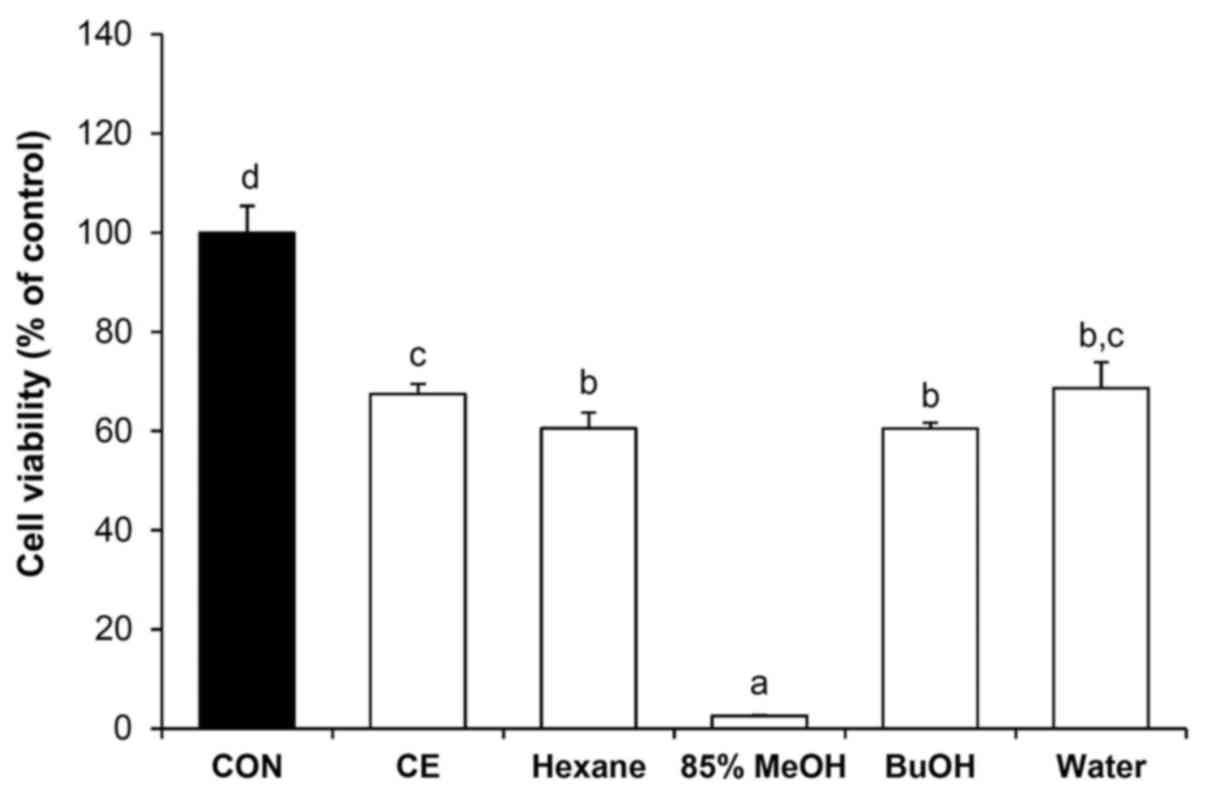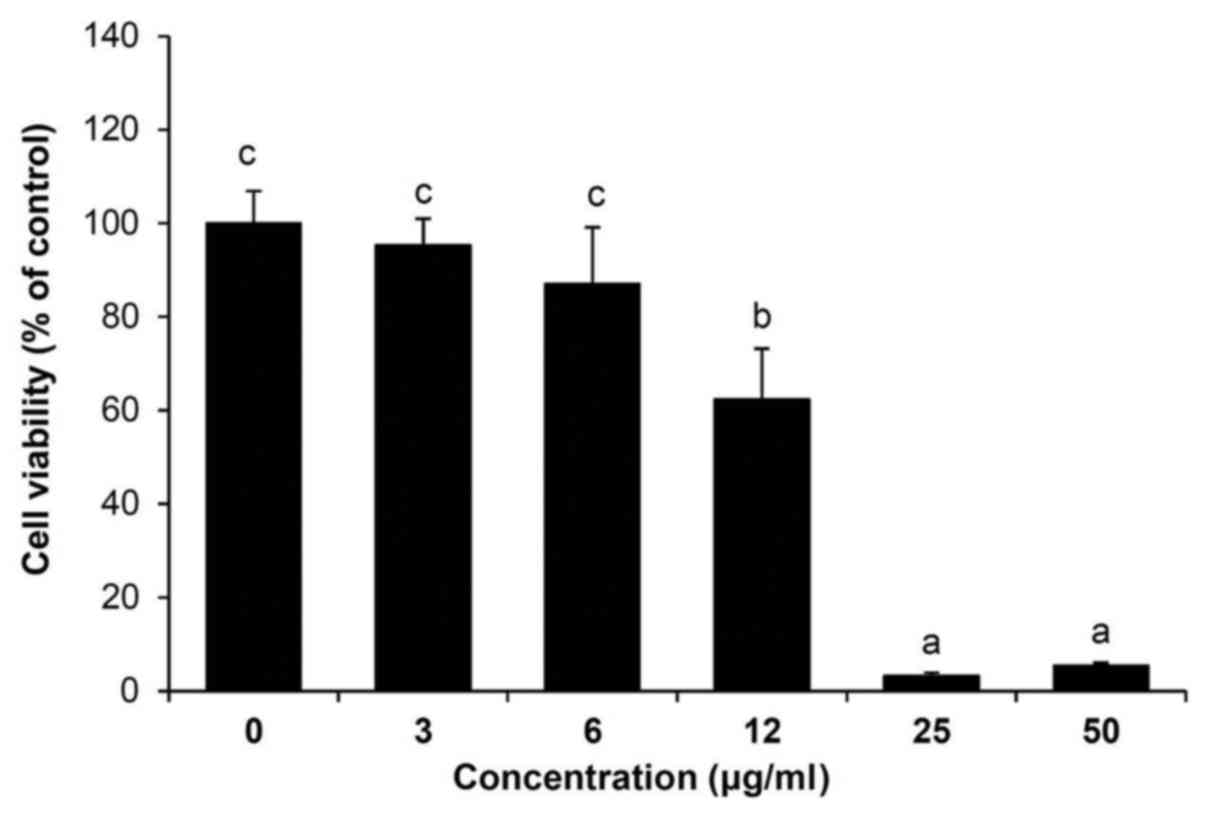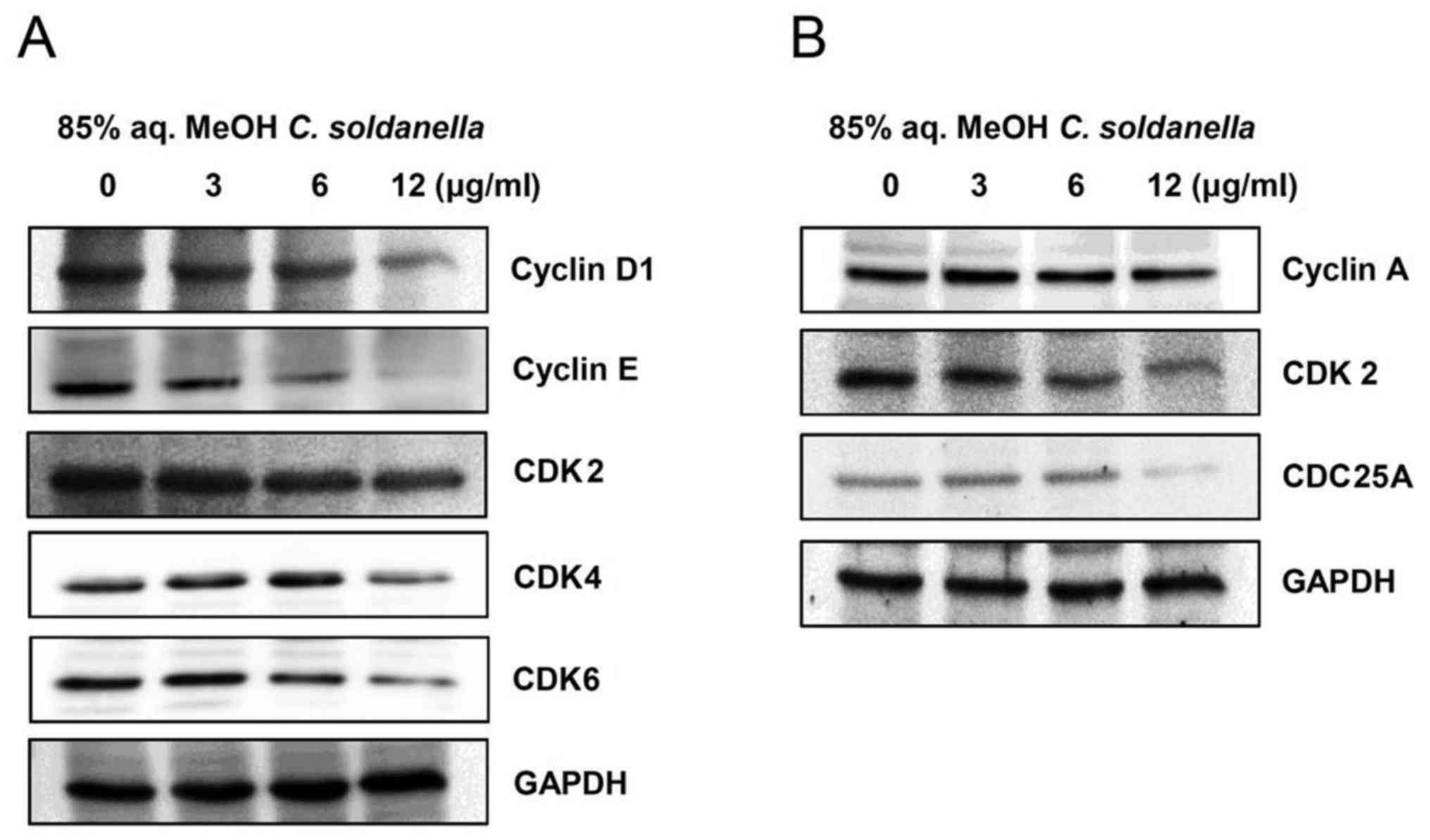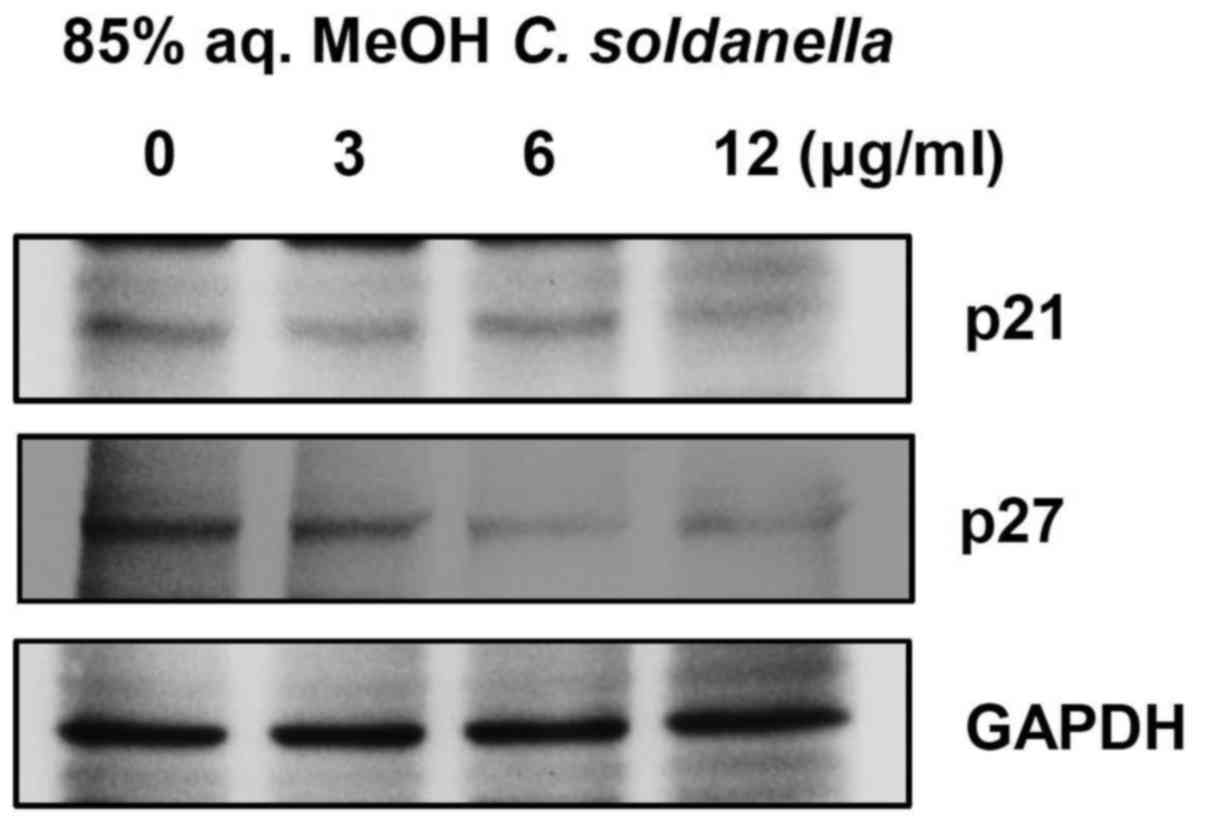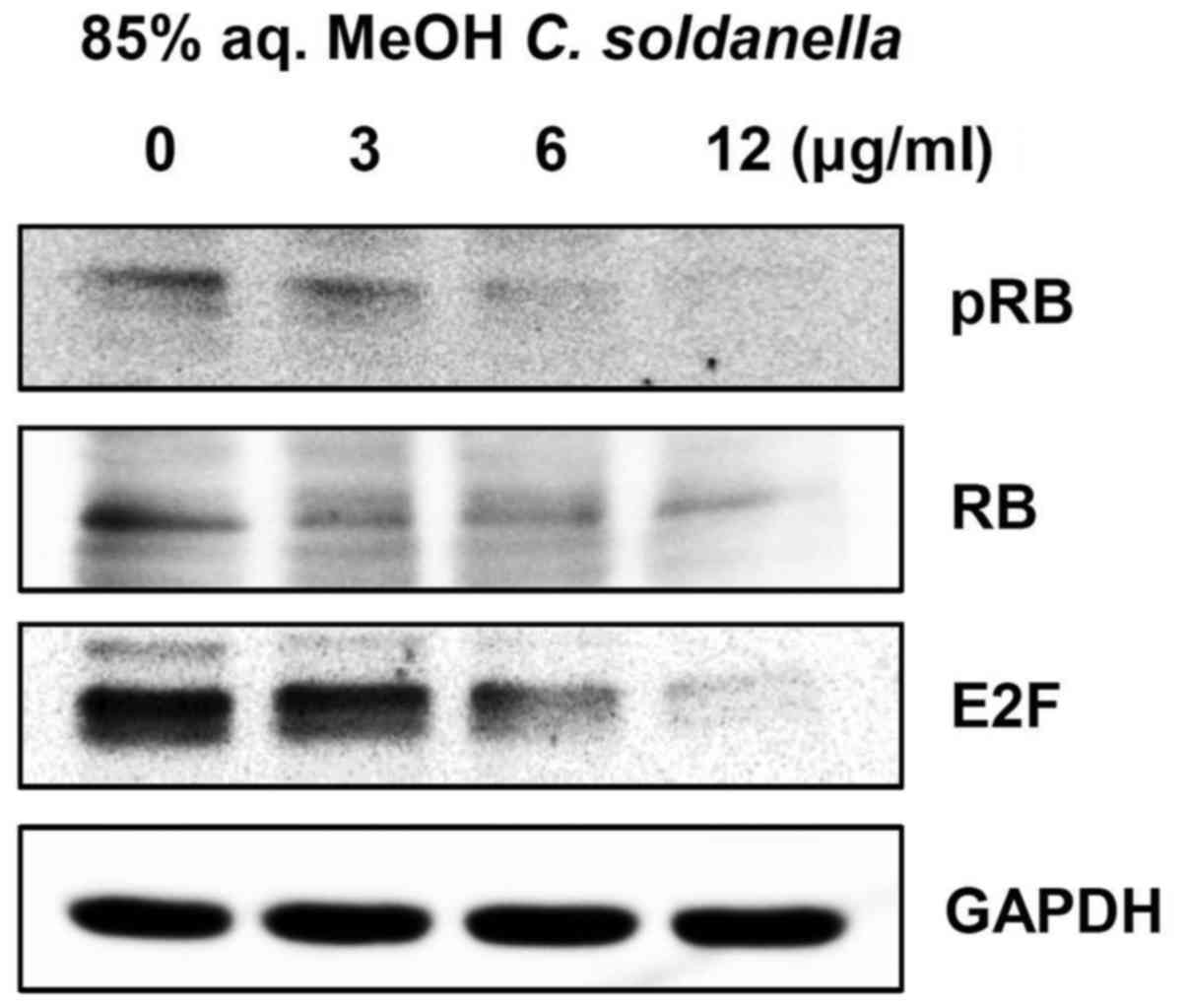|
1
|
Li YL, Zhang J, Min D, Hongyan Z, Lin N
and Li QS: Anticancer effects of
1,3-Dihydroxy-2-Methylanthraquinone and the ethyl acetate fraction
of Hedyotis Diffusa Willd against HepG2 carcinoma cells mediated
via Apoptosis. PLoS One. 11:e01515022016. View Article : Google Scholar : PubMed/NCBI
|
|
2
|
Jin S, Park HJ, Oh YN, Kwon HJ, Kim JH,
Choi YH and Kim BW: Anti-cancer activity of osmanthus matsumuranus
extract by inducing G2/M arrest and apoptosis in human
hepatocellular carcinoma Hep G2 cells. J Cancer Prev. 20:241–249.
2015. View Article : Google Scholar
|
|
3
|
Lee JI, Kwak MK, Park HY and Seo Y:
Cytotoxicity of meroterpenoids from Sargassum siliquastrum against
human cancer cells. Nat Prod Commun. 8:431–432. 2013.PubMed/NCBI
|
|
4
|
Siegel RL, Miller KD and Jemal A: Cancer
statistics, 2015. CA Cancer J Clin. 65:5–29. 2015. View Article : Google Scholar : PubMed/NCBI
|
|
5
|
Tang Z, Zhou X, Lin Z, Yang B, Ma Z, Ye S,
Wu Z, Fan J, Liu Y, Liu K, et al: Surgical treatment of
hepatocellular carcinoma and related basic research with special
reference to recurrence and metastasis. Chin Med J (Engl).
112:887–891. 1999.
|
|
6
|
Yu Z, Luo X, Wang C, Ye J, Liu S, Xie L,
Wang F and Bao J: Baicalin promoted site-2 protease and not site-1
protease in endoplasmic reticulum stress-induced apoptosis of human
hepatocellular carcinoma cells. FEBS Open Bio. 6:1093–1101. 2016.
View Article : Google Scholar : PubMed/NCBI
|
|
7
|
Chen NH and Zhong JJ: Ganoderic acid Me
induces G1 arrest in wild-type p53 human tumor cells while G1/S
transition arrest in p53-null cells. Process Biochem. 44:928–933.
2009. View Article : Google Scholar
|
|
8
|
Kong CS, Um YR, Lee JI, Kim YA, Yea SS and
Seo Y: Constituents isolated from Glehnia littoralis suppress
proliferations of human cancer cells and MMP expression in HT1080
cells. Food Chem. 120:385–394. 2010. View Article : Google Scholar
|
|
9
|
Stan SD, Kar S, Stoner GD and Singh SV:
Bioactive food components and cancer risk reduction. J Cell
Biochem. 104:339–356. 2008. View Article : Google Scholar
|
|
10
|
Um YR, Kong CS, Lee JI, Kim YA, Nam TJ and
Seo Y: Evaluation of chemical constituents from Glehnia littoralis
for antiproliferative activity against HT-29 human colon cancer
cells. Process Biochem. 45:114–119. 2010. View Article : Google Scholar
|
|
11
|
Mary JS, Vinotha P and Pradeep AM:
Screening for in vitro cytotoxic activity of seaweed, Sargassum sp.
against Hep-2 and MCF-7 cancer cell lines. Asian Pac J Cancer Prev.
13:6073–6076. 2012. View Article : Google Scholar : PubMed/NCBI
|
|
12
|
Shamsabadi FT, Khoddami A, Fard SG,
Abdullah R, Othman HH and Mohamed S: Comparison of tamoxifen with
edible seaweed (Eucheuma cottonii L.) extract in suppressing breast
tumor. Nutr Cancer. 65:255–262. 2013. View Article : Google Scholar : PubMed/NCBI
|
|
13
|
Rubiolo JA, López-Alonso H, Roel M,
Vieytes MR, Thomas O, Ternon E, Vega FV and Botana LM: Mechanism of
cytotoxic action of crambescidin-816 on human liver-derived tumour
cells. Br J Pharmacol. 171:1655–1667. 2014. View Article : Google Scholar :
|
|
14
|
Russo GL, Russo M, Castellano I,
Napolitano A and Palumbo A: Ovothiol isolated from sea urchin
oocytes induces autophagy in the Hep-G2 cell line. Mar Drugs.
12:4069–4085. 2014. View Article : Google Scholar : PubMed/NCBI
|
|
15
|
Kawee-Ai A and Kim SM: Application of
microalgal fucoxanthin for the reduction of colon cancer risk:
Inhibitory activity of fucoxanthin against beta-glucuronidase and
DLD-1 cancer cells. Nat Prod Commun. 9:921–924. 2014.PubMed/NCBI
|
|
16
|
Malve H: Exploring the ocean for new drug
developments: Marine pharmacology. J Pharm Bioallied Sci. 8:83–91.
2016. View Article : Google Scholar : PubMed/NCBI
|
|
17
|
Gudiña EJ, Teixeira JA and Rodrigues LR:
Biosurfactants produced by marine microorganisms with therapeutic
applications. Mar Drugs. 14:382016. View Article : Google Scholar :
|
|
18
|
Talero E, García-Mauriño S, Ávila-Román J,
Rodríguez-Luna A, Alcaide A and Motilva V: Bioactive compounds
isolated from microalgae in chronic inflammation and cancer. Mar
Drugs. 13:6152–6209. 2015. View Article : Google Scholar : PubMed/NCBI
|
|
19
|
Li R: Marinopyrroles: Unique drug
discoveries based on marine natural products. Med Res Rev.
36:169–189. 2016. View Article : Google Scholar
|
|
20
|
Kong CS, Lee JI, Kim YA, Kim JA, Bak SS,
Hong JW, Park HY, Yea SS and Seo Y: Evaluation on anti-adipogenic
acitivity of flavonoids glucopyranosides from Salicornia herbacea.
Process Biochem. 47:1073–1078. 2012. View Article : Google Scholar
|
|
21
|
Hesp PA: Ecological processes and plant
adaptations on coastal dunes. J Arid Environ. 21:165–191. 1991.
|
|
22
|
Maun MA: Adaptations of plants to burial
in coastal sand dunes. Can J Bot. 76:713–738. 1998.
|
|
23
|
Lawlor DW and Cornic G: Photosynthetic
carbon assimilation and associated metabolism in relation to water
deficits in higher plants. Plant Cell Environ. 25:275–294. 2002.
View Article : Google Scholar : PubMed/NCBI
|
|
24
|
Lee JI, Kong CS, Jung ME, Hong JW, Lim SY
and Seo Y: Antioxidant activity of the halophyte Limonium
tetragonum and its major active components. Biotechnol Bioprocess
Eng; BBE. 16:992–999. 2011. View Article : Google Scholar
|
|
25
|
Ksouri R, Megdiche W, Falleh H, Trabelsi
N, Boulaaba M, Smaoui A and Abdelly C: Influence of biological,
environmental and technical factors on phenolic content and
antioxidant activities of Tunisian halophytes. C R Biol.
331:865–873. 2008. View Article : Google Scholar : PubMed/NCBI
|
|
26
|
Kim YA, Kong CS, Lee JI, Kim H, Park HY,
Lee HS, Lee C and Seo Y: Evaluation of novel antioxidant
triterpenoid saponins from the halophyte Salicornia herbacea.
Bioorg Med Chem Lett. 22:4318–4322. 2012. View Article : Google Scholar : PubMed/NCBI
|
|
27
|
Kim YA, Kong CS, Yea SS and Seo Y:
Constituents of Corydalis heterocarpa and their anti-proliferative
effects on human cancer cells. Food Chem Toxicol. 48:722–728. 2010.
View Article : Google Scholar
|
|
28
|
Oueslati S, Ksouri R, Pichette A, Lavoie
S, Girard-Lalancette K, Mshvildadze V, Abdelly C and Legault J: A
new flavonol glycoside from the medicinal halophyte Suaeda
fruticosa. Nat Prod Res. 28:960–966. 2014. View Article : Google Scholar : PubMed/NCBI
|
|
29
|
Kong NN, Fang ST, Wang JH, Wang ZH and Xia
CH: Two new flavonoid glycosides from the halophyte Limonium
franchetii. J Asian Nat Prod Res. 16:370–375. 2014. View Article : Google Scholar : PubMed/NCBI
|
|
30
|
Fang ST, Liu X, Kong NN, Liu SJ and Xia
CH: Two new withanolides from the halophyte Datura stramonium L.
Nat Prod Res. 27:1965–1970. 2013. View Article : Google Scholar : PubMed/NCBI
|
|
31
|
Bae CY, Hwang JS, Bae JJ, Choi SC, Lim SH,
Choi DG, Kim JG and Choo YS: Physiological responses of Calystegia
soldanella under drought stress. J Ecol Environ. 36:255–265. 2013.
View Article : Google Scholar
|
|
32
|
Bae KH: The Medicinal Plants of Korea.
Korea: Kyo-Hak publishing, Seoul; 2000
|
|
33
|
Lee YS, Kwak CG and Kim NW: Nutritional
characteristics of Calystegia japonica. Korean J Food Preserv.
19:619–625. 2012. View Article : Google Scholar
|
|
34
|
Takagi S, Yamaki M, Masuda K and Kubota M:
Studies on the purgative drugs. IV. On the constituents of
Calystegia japonica Choisy (author's transl). Yakugaku Zasshi.
97:1369–1371. 1977.In Japanese. PubMed/NCBI
|
|
35
|
Kim Y, Min HY, Park HJ, Lee EJ, Park EJ,
Hwang HJ, Jin C, Lee YS and Lee SK: Suppressive effects of nitric
oxide production and inducible nitric oxide synthase (iNOS) gene
expression by Calystegia soldanella methanol extract on
lipopolysaccharide-activated RAW 264.7 cells. Eur J Cancer Prev.
13:419–424. 2004. View Article : Google Scholar : PubMed/NCBI
|
|
36
|
Huang Z and Feng C: Experimental study on
anti-inflammatory and analgesic effects of water extracts of
Calystegia soldanella. Chin Arch Tradit Chin Med. 6:72010.
|
|
37
|
Lee JI, Kim IH, Choi YH, Kim EY and Nam
TJ: PTP1B inhibitory effect of alkyl p-coumarates from Calystegia
soldanella. Nat Prod Commun. 9:1585–1588. 2014.PubMed/NCBI
|
|
38
|
Min HY, Kim Y, Lee EJ, Hwang HJ, Park EJ
and Lee SK: Cytotoxic activities of indigenous plant extracts in
cultured human cancer cells. Nat Prod Sci. 8:170–172. 2002.
|
|
39
|
Ono M, Takigawa A, Kanemaru Y, Kawakami G,
Kabata K, Okawa M, Kinjo J, Yokomizo K, Yoshimitsu H and Nohara T:
Calysolins V–IX, resin glycosides from Calystegia soldanella and
their antiviral activity toward herpes. Chem Pharm Bull (Tokyo).
62:97–105. 2014. View Article : Google Scholar
|
|
40
|
Ono M, Kawakami G, Takigawa A, Kabata K,
Okawa M, Kinjo J, Yokomizo K, Yoshimitsu H and Nohara T: Calysolins
X-XIII, resin glycosides from Calystegia soldanella, and their
antiviral activity toward herpes simplex virus. Chem Pharm Bull
(Tokyo). 62:839–844. 2014. View Article : Google Scholar
|
|
41
|
Ono M, Takigawa A, Muto H, Kabata K, Okawa
M, Kinjo J, Yokomizo K, Yoshimitsu H and Nohara T: Antiviral
activity of four new resin glycosides calysolins XIV-XVII from
Calystegia soldanella against Herpes Simplex Virus. Chem Pharm Bull
(Tokyo). 63:641–648. 2015. View Article : Google Scholar
|
|
42
|
Nidiry ES, Ganeshan G and Lokesha AN:
Antifungal activity and isomerization of octadecyl p-coumarates
from Ipomoea carnea subsp. fistulosa. Nat Prod Commun. 6:1889–1892.
2011.
|
|
43
|
Gaspar EMM: New pentasaccharide
macrolactone from the European Convolvulaceae Calystegia
soldanella. Tetrahedron Lett. 40:6861–6864. 1999. View Article : Google Scholar
|
|
44
|
Gaspar EMM: Soldanelline B-The first
acylated nonlinear tetrasaccharide macrolactone from the European
Convolvulaceae Calystegia soldanella. Eur J Org Chem. 2001:369–373.
2001. View Article : Google Scholar
|
|
45
|
Takigawa A, Setoguchi H, Okawa M, Kinjo J,
Miyashita H, Yokomizo K, Yoshimitsu H, Nohara T and Ono M:
Identification and characterization of component organic and
glycosidic acids of crude resin glycoside fraction from Calystegia
soldanella. Chem Pharm Bull (Tokyo). 59:1163–1168. 2011. View Article : Google Scholar
|
|
46
|
Takigawa A, Muto H, Kabata K, Okawa M,
Kinjo J, Yoshimitsu H, Nohara T and Ono M: Calysolins I–IV, resin
glycosides from Calystegia soldanella. J Nat Prod. 74:2414–2419.
2011. View Article : Google Scholar : PubMed/NCBI
|
|
47
|
Asano N, Yokoyama K, Sakurai M, Ikeda K,
Kizu H, Kato A, Arisawa M, Höke D, Dräger B, Watson AA, et al:
Dihydroxynortropane alkaloids from calystegine-producing plants.
Phytochemistry. 57:721–726. 2001. View Article : Google Scholar : PubMed/NCBI
|
|
48
|
Tatsuzawa F, Mikanagi Y and Saito N:
Flower anthocyanins of Calystegia in Japan. Biochem Syst Ecol.
32:1235–1238. 2004. View Article : Google Scholar
|
|
49
|
Tori M, Ohara Y, Nakashima K and Sono M:
Caffeic and coumaric acid esters from Calystegia soldanella.
Fitoterapia. 71:353–359. 2000. View Article : Google Scholar : PubMed/NCBI
|
|
50
|
Ahn NR, Ko JM and Cha HC: Comparison of
flavonoid profiles between leaves and stems of Calystegia
soldanella and Calystegia japonica. Am J Plant Sci. 3:1073–1076.
2012. View Article : Google Scholar
|
|
51
|
Ashkenazi A: Targeting the extrinsic
apoptosis pathway in cancer. Cytokine Growth Factor Rev.
19:325–331. 2008. View Article : Google Scholar : PubMed/NCBI
|
|
52
|
Yang Y, Zhu X, Chen Y, Wang X and Chen R:
p38 and JNK MAPK, but not ERK1/2 MAPK, play important role in
colchicine-induced cortical neurons apoptosis. Eur J Pharmacol.
576:26–33. 2007. View Article : Google Scholar : PubMed/NCBI
|
|
53
|
Canavese M, Santo L and Raje N: Cyclin
dependent kinases in cancer: Potential for therapeutic
intervention. Cancer Biol Ther. 13:451–457. 2012. View Article : Google Scholar : PubMed/NCBI
|
|
54
|
Sperka T, Wang J and Rudolph KL: DNA
damage checkpoints in stem cells, ageing and cancer. Nat Rev Mol
Cell Biol. 13:579–590. 2012. View Article : Google Scholar : PubMed/NCBI
|
|
55
|
Dobashi Y, Takehana T and Ooi A:
Perspectives on cancer therapy: Cell cycle blockers and
perturbators. Curr Med Chem. 10:2549–2558. 2003. View Article : Google Scholar : PubMed/NCBI
|
|
56
|
Paternot S, Bockstaele L, Bisteau X,
Kooken H, Coulonval K and Roger PP: Rb inactivation in cell cycle
and cancer: The puzzle of highly regulated activating
phosphorylation of CDK4 versus constitutively active CDK-activating
kinase. Cell Cycle. 9:689–699. 2010. View Article : Google Scholar : PubMed/NCBI
|
|
57
|
George Rosenker KM, Paquette WD, Johnston
PA, Sharlow ER, Vogt A, Bakan A, Lazo JS and Wipf P: Synthesis and
biological evaluation of 3-aminoisoquinolin-1(2H)-one based
inhibitors of the dual-specificity phosphatase Cdc25B. Bioorg Med
Chem. 23:2810–2818. 2015. View Article : Google Scholar : PubMed/NCBI
|
|
58
|
Tilaoui M, Mouse HA, Jaafari A and Zyad A:
Differential effect of artemisinin against cancer cell lines. Nat
Prod Bioprospect. 4:189–196. 2014. View Article : Google Scholar : PubMed/NCBI
|



